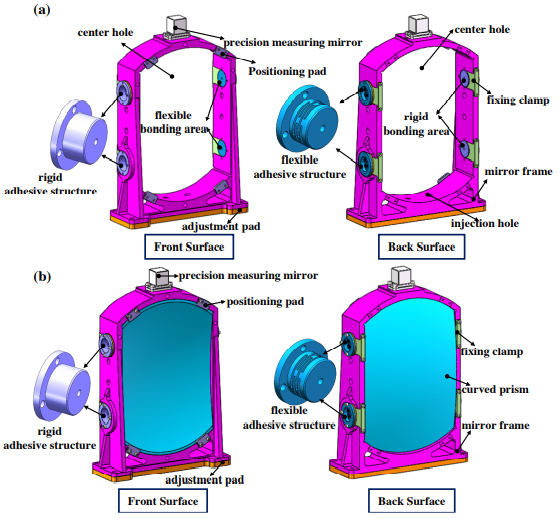A research team led by Prof. Dr. Hu Bingliang from the Xi’an Institute of Optics and Precision Mechanics (XIOPM) of the Chinese Academy of Sciences (CAS) has recently designed a rigid-flexible, dual-mode coupling support structure for space-based rectangular curved prisms (SRCPs) to obtain high reliability and stability support of optical components of space remote sensors. Their up-to-date results were published in Applied Optics.
Curved prisms have been widely used in the spectroscopic systems of remote sensors due to its unique advantages on light splitting and imaging. However, curved prisms do not have a rotationally symmetric body, which brings about a lot of problems in fixed installation process.
Through in-depth theoretical analysis and repeated optimization,the research team above developed a new rigid–flexible, dual-mode coupling support structure to achieve the effective support of SRCPs.

Rigid–flexible, dual-mode coupling support structure for the SRCP. (Image by XIOPM)
As a compromise scheme, this design allows the whole structure to have enough rigidity to meet the index requirement of the system and allows the local part to have enough flexibility to release different stresses.
In this design, the support structure of the curved prism includes the mirror frame, two rigid adhesive structures, two flexible adhesive structures, four fixing clamps, four positioning pads, the adjustment pad, and a precision measuring mirror. Besides, to facilitate the positioning of the supporting structure, the front surface of the curved prism was provided with two circular arc flat ends.
The simulation analyses and mechanical tests performed on this designed structure showed that all indexes were better than the design requirements.
Further systematic test results showed that the proposed rigid-flexible, dual-mode peripheral bonding support structure can support optical elements with high accuracy and stability. Even under the influence of gravity load and temperature loads, the fabrication error, assembly error, and other factors, the surface shape error of the curved prism subassembly was slight, thus conducive to realize the reliability of the support structure.
The researchers believed that this new designed structure could even bear the complex mechanical environment of vibration and shock when the satellite platform was launched.
This work was supported by the Natural Science Foundation of Shaanxi Province, and National Natural Science Foundation of China.
Download: